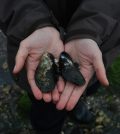Posts for tag "aquatic species"
Monitoring Mariculture in the Gulf of Alaska
The mariculture industry in the Gulf of Alaska has been steadily growing in recent years, guided by ongoing research to help refine farm location and cultivation practices. A subset of aquaculture, mariculture focuses on rearing organisms in...
- Posted May 5, 2025
Tsunami’s Effects Lasting Years for Marine Creatures
Research into the “rafting” of animals on plastics and other debris in the ocean after the 2011 tsunami reveals other insights.
- Posted August 5, 2019
Deep-sea Biodiversity Expedition Uncovers Thousands of Creatures
A research team from Singapore and Indonesia brought thousands of samples back from a deep-sea biodiversity expedition, including at least 12 new species.
- Posted July 10, 2018
Subtleties of Submarine Groundwater Discharge and Coral Reefs
Research sheds new light onto the effects of submarine groundwater discharge on coral reef growth and bioerosion.
- Posted May 18, 2018
Genetic Study of Yeti Crabs Reveals Likely Common Ancestor—and Vulnerability
Phylogenetic analysis of all currently identified species of yeti crabs reveals a common ancestor, and possibly more vulnerability to environmental changes.
- Posted May 11, 2018
Rising Atmospheric CO2 Levels Affecting Cephalopod Behaviors
New research shows that rising levels of atmospheric CO2 may affect cephalopod behaviors—in potentially detrimental ways.
- Posted April 23, 2018
Long-Term Monitoring Aids Scientists Studying Sea Star Wasting Mystery
Scientists build on a foundation of decades of monitoring to help unravel the mysterious sea star wasting disease.
- Posted April 18, 2018
Horseshoe Crabs and Red Knots: Delaware NERR Monitoring Offers Glimpse into Coastal Wildlife
Environmental monitoring of Delaware’s National Estuarine Research Reserve reveals a rich harvest of some of nature’s most ancient and remarkable characters.
- Posted December 30, 2017
Stranded: What Dolphins with Pathological Signs of Alzheimer’s Disease Can Tell Us
New research shows dolphins exhibit the same pathological hallmarks of Alzheimer’s disease that are found in human brains, and this may cause stranding.
- Posted December 28, 2017
Mighty Mussels (and Oysters) are Cleaning Up Water Across the US
Three different projects across the US are using bivalves to test and improve water quality and restore ecosystems.
- Posted December 21, 2017
A Clean Water Act Success Story: Sportfish Return to the Illinois River
New research shows the 1972 Clean Water Act almost singlehandedly brought sportfish populations back to the Illinois River.
- Posted November 27, 2017
In Ontario Lakes, Non-Native Bass Impact Native Fish
Non-native bass have had impacts on native fish species in Ontario lakes, according to scientists from the University of Toronto.
- Posted December 12, 2016
Lake Michigan Yellow Perch Bounce Back After Commercial Ban
After a commercial fishing ban, Purdue University scientists lead a study finding quick recovery of Lake Michigan yellow perch maturation schedules.
- Posted December 5, 2016
Colorado River Fish Contain Levels Of Selenium, Mercury
Colorado River fish, despite inhabiting a protected waterway, are found to contain levels of selenium and mercury by Idaho State researchers.
- Posted December 2, 2016
Native Fish Eat Asian Carp On Illinois River, Invasive Still Prolific
Western Illinois University investigators sample native fish on the Illinois River to gauge their preferences for eating Asian Carp, as a control method.
- Posted November 16, 2016
As Smallmouth Bass Move In, Walleye In Ontario Lakes At Risk
Data analysis and modeling help York University scientists predict how climate change and warmer waters may impact Ontario walleye stocks.
- Posted November 10, 2016
Marine Protected Areas Help Channel Islands Fish
The Channel Islands Marine Protected Areas have been good for fish, find researchers at the University of California, Santa Barbara.
- Posted November 9, 2016
High Levels Of Microcystin In Some San Francisco Bay Shellfish
Some shellfish in San Francisco Bay contain levels of microcystin beyond those noted as safe for consumption, say University of California researchers.
- Posted November 8, 2016
Underwater Cameras And Autonomous Vehicles Track Leatherback Turtles
Woods Hole Oceanographic Institution scientists use TurtleCam underwater cameras and an autonomous vehicle to follow leatherback turtles.
- Posted November 4, 2016
How Midwater Crustaceans Vanish From Predators
Duke University and Smithsonian Institution scientists find that midwater crustaceans have anti-reflective coatings to protect them from predators.
- Posted November 2, 2016






















